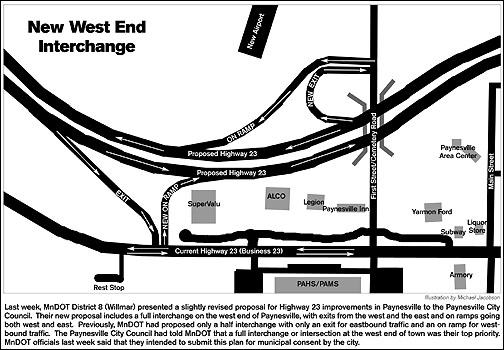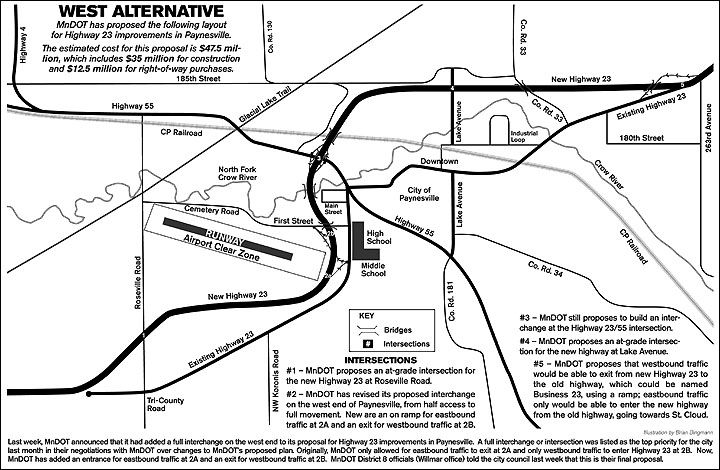MnDOT adds full interchange to west end
 The Paynesville City Council - during two council discussions in November and during a meeting with Willmar MnDOT officials on Monday, Nov. 21 - had agreed that full access, either a full-movement interchange or intersection, was the top city priority.
The Paynesville City Council - during two council discussions in November and during a meeting with Willmar MnDOT officials on Monday, Nov. 21 - had agreed that full access, either a full-movement interchange or intersection, was the top city priority.
Until last week, Willmar MnDOT officials had resisted having a full access on the west end, citing access management guidelines that limit spacings on highways classified 2A to every mile. The new proposed interchange does not meet these access spacing guidelines, but it was given preliminary approval by the geometrics unit at the central office of MnDOT, according to MnDOT project manager Lowell Flaten.
Previously, MnDOT in Willmar had proposed only a half-diamond interchange on the west end. This would have allowed eastbound traffic (coming from New London) to exit on the west end, and it would have allowed westbound traffic (going to New London) to enter the highway at the west end. It would not have allowed westbound traffic (coming from Richmond) to exit, and it would not have allowed entry for eastbound traffic (going to Richmond).
The revised design includes both an exit for westbound traffic (coming from Richmond) and an entrance for eastbound traffic (going to Richmond).
"It accommodates all four of the traffic movements," said Flaten, who added that Willmar MnDOT would not reclassify the new highway as 2B (defined as bordering or going through a municipality, as requested by the city) and intends to keep it as 2A (rural expressway).
Flaten - who spent 15 minutes presenting MnDOT's revised proposal at the council meeting and another 15 minutes answering audience questions, along with MnDOT District 8 planner Patrick Weidemann - also had good news over the second city request. MnDOT, he said again, has no objections to renaming the current highway as Business 23 once the new highway is built. The MnDOT officials did confirm that MnDOT would intend to turn the old highway over to the county, who either could take it as a county road or try and turn it back to the city and/or township. Ultimately, the name of the road will need the permission of the new responsible government unit, but MnDOT has no objections to naming it Business 23.
The council, as well as business interests, has asked for this name to indicate to traffic that they can exit in Paynesville - to sightsee or stop - and get back onto Highway 23.
MnDOT had negative responses to two other city requests: to help pay for upgrades of Lake Avenue and to change the west-end split for Highway 23.
Lake Avenue is currently a five-ton road but will need to be strengthened to accommodate expected truck traffic to the Industrial Park and to downtown. Flaten said it violates state statute for MnDOT to go all the way to the bridge over the Crow River. Instead, they need to use a logical touchdown, 50 to 150 feet off the new highway. "Our belief is we can't pay for that, so our answer is no," he said.
The council had asked that eastbound traffic (coming from New London) should be able to exit right onto the old highway when the new highway splits by the Stearns-Kandiyohi line. This has "lots of complexity," said Flaten, such as not meeting access spacing and introducing an exit as well as splitting into four lanes. "Our decision was not to change this access," he said.
"What you see here is essentially what we intend to submit for municipal consent," said Flaten.
Council response to the MnDOT revisions was brief and inconclusive. Councilor Dennis Zimmerman said he was pleased with the full access on the west end. Councilor Jeff Bertram said it was a good faith attempt, even if he was not sure if they were there yet.
"This is MnDOT's final position. We intend to submit this (for municipal consent)," replied Weidemann.
Adding two more ramps has strained funding for this project, added Weidemann, who reminded the council that Willmar MnDOT officials will be seeking additional federal funds ($10 million has already been allocated) from the area transportation partnership in January in order to construct this project in 2009. (Bertram said that city officials could still object to the project while MnDOT is seeking these additional funds.)
The two additional ramps for the full interchange on the west end raises the construction costs for this project by $1 million, according to Flaten. The bridge unit at the central office has also added $2 million in bridge costs after a review, bringing the projected construction costs to $35 million. Additionally, MnDOT expects to spend $12.5 million for right-of-way purchases, making its current project cost estimate $47.5 million.
During the audience questions - nearly two dozen people attended the meeting, including Sen. Michelle Fischbach (R-Paynesville) while Rep. Larry Hosch (DFL-St. Joseph) sent regrets - local business owner Stan Yarmon, who represents a business group, asked why MnDOT didn't want Paynesville to have any stoplights, especially since there are other stoplights on 23 from Willmar to St. Cloud. MnDOT could save money without all these loops and overpasses by using stoplights, Yarmon added.
Weidemann said that Richmond, Spicer, and Cold Spring chose thru-town routes for Highway 23. "We have heard by resolution that you did not want it thru town," he said, referring to the city council's backing of the selected west route. Willmar MnDOT has cited the city council's backing of the west route as a key reason for its selection.
The west route, as proposed, still goes through the city limits on the west end of Paynesville.
In response to another audience question, Flaten said that the speed limit would be set by a speed survey. "I don't know if it'll be 65 but it'll be higher," he said. "I would not expect to see 45."
Does MnDOT want standardized intersections?, asked local business owner Dick Johnson. When Flaten answered yes, Johnson wondered why they had proposed a divided intersection on the west end. (See map.)
MnDOT's preference was for a half interchange, replied Flaten, but they wanted to accommodate the city in order to get municipal consent.
Willmar MnDOT expects to submit this proposal around the end of the month for consideration of municipal consent by the city.
Once the city receives this formal request, within 15 days the council must set a date for a public hearing, according to MnDOT policy. The public hearing must have 30 days of public notice and must be held within 60 days of the formal request by MnDOT for municipal consent.
The city council then has 90 days to consider giving its municipal consent, according to MnDOT policy.
This means that if MnDOT submits its request by the end of December, the city council at their first meeting in January would need to set a date for the public hearing in February. The public could then give their opinions at that public hearing, which the council members could consider until May.
The council can give municipal consent by passing a resolution or by not taking any action within that 90-day window.
The council could also deny the municipal consent or pass it with conditions. This is considered a denial unless MnDOT agrees to the city conditions.
"If you choose as a council to turn it down," said Weidemann, "we will step back and look at our options."
MnDOT could withdraw, appeal, or change its proposal, though the Willmar office has said this is their final proposal.
If MnDOT withdraws, they could keep the Draft EIS open and then re-examine its findings in the future, added Flaten. In other words, it could reevaluate the west route as the "preferred alternative."
If the project is delayed, MnDOT could use its current $10 million for right-of-way purchases, Weidemann added, but it cannot start construction without municipal consent (or by winning the appeals process).
Could MnDOT choose something worse than this?, asked local business owner Chuck Koshiol. Possibly, if you consider, say the east or the far west bypass, worse, said Flaten.
"Now we see how MnDOT negotiates," said Johnson after the MnDOT officials left. "They don't."

Contact the author at editor@paynesvillepress.com • Return to News Menu
Home | Marketplace | Community